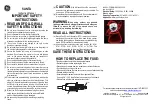
Multiplexer User's Guide
Confidential / Released
s
m
o
b
i
l
e
Mux_guide_v06
Page 15 of 36
30.06.2004
RTS/CTS on the logical channels
The customer application needs to regulate the data flow according to the logical flow
control. The implementation of the WinMux2k is a good example. It maps the 3 decoded
channels to 3 serial interfaces as well as the logical flow control information (FC-BIT in MSC
message) directly on the RTS/CTS-control lines.
In this case CTS superposes the STOP information (data sending disabled) sent by the
module to control the data transmission from the customer application to the module. If RTS
is reset, a STOP is transmitted to the module to control the data transmission from the
module to the customer application. Figure 2 illustrates the data flow.
Figure 2: Logical flow control and RTS/CTS signaling behind the decoder
RING/DCD
Unlike all other lines DCD and RING are transmitted additionally on the UART directly by the
module. These signals are logical ORs from the three logical channel status lines. However,
the customer application must carefully decide how to handle these lines and ensure, that no
conflicts occur between the different channels. E.g. in some situations it may be advisable to
display RING on channel 1 only.
Please keep in mind that a call can be accepted on one channel only. Therefore some kind
of mutual locking mechanism must be used.
MS
Module
TE
Customer application
(WinMux2k)
Multiplexer
Protocol
GSM 07.10
Multiplexer
Protocol
GSM 07.10
ser
IO
ser
IO
COM M
COM N
COM P
CSD
AT
Interface
RTS/CTS
RTS/CTS
Channel 2,3:
RTS
(/CTS)
Channel 1:
RTS/CTS
Controller
(maps RTS/CTS of
the unframed
channels to log. FC)
RTS/CTS
logical flow control (FC)
HW flow control
Flow control between the applications
















































